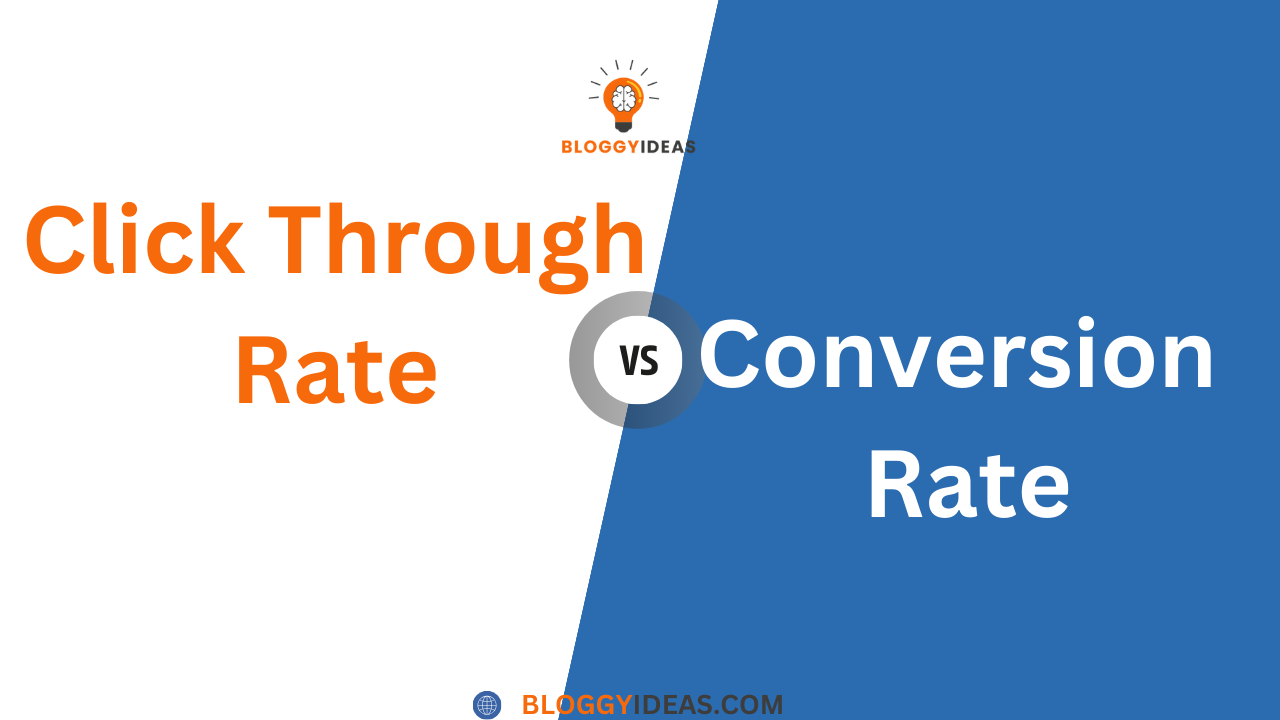Click Through Rate vs Conversion Rate
“Quick Overview” Marketing campaigns resemble puzzles, and grasping the components that form the larger picture is vital for success. Two fundamental puzzle pieces in marketing are Click-Through Rate (CTR) and Conversions Rate (CR).
In this article, we’ll explore the significance of these metrics, distinguish between them, and provide tips on enhancing their performance. Join us on the thrilling journey of deciphering CTR and CR!
What is the Click Through Rate
A click-through rate (CTR) is a metric utilized in advertising and marketing to gauge the effectiveness of a digital campaign. This metric reflects the percentage of users who click on your advertisement compared to the total number of people it was displayed to.
CTR serves as a crucial performance indicator for advertisers, aiding them in assessing the success of online campaigns and implementing necessary adjustments. A higher CTR may indicate that the ad resonates well with the audience and performs admirably. Conversely, a lower CTR implies that the content may lack engagement.
How to Calculate Click-Through Rate (CTR)
By calculating the Click-Through Rate (CTR), you can ascertain the ratio of users who clicked on a link to the total number of users who viewed it. CTR is typically expressed as a percentage, so multiply it by 100.
To calculate CTR, simply divide the total number of clicks by the total number of impressions.
- CTR = (Clicks / Impressions) * 100
An example will help us better comprehend it. If you have 100 clicks and 1,000 impressions.
- CTR = (100 / 1000) * 100 = 10%.
Keep in mind that CTR is only one metric for evaluating the effectiveness of your content. Take into account conversion rates, engagement metrics, and other pertinent performance indicators based on your objectives.
Importance of Click-Through Rate
- Helps in Performance Measurement: CTR provides advertisers with a simple way to gauge the performance of their content and ads, enabling them to pinpoint weaknesses and errors in their strategy. Ultimately, this assists them in taking actions that closely align with their target audience.
- Effectiveness of Ads: For advertisers, CTR offers valuable insights into the effectiveness of their ad campaigns. A low CTR may indicate the need for improvement in the ad’s messaging or visuals, while a high CTR suggests that the ad is connecting well with the audience.
- Relevance & Quality: Search engines and social media platforms frequently utilize CTR as an indicator to assess the relevance and quality of content. If a search result or post garners a high CTR, it indicates that the content effectively addresses users’ needs and interests.
- Ad Placement and Positioning: The Click-Through Rate (CTR) assists advertisers in pinpointing the ad placements or positions on a webpage or app that are more likely to capture user attention and generate clicks. This data is invaluable for refining ad placement strategies.
Factors Influencing Click-Through Rate (CTR) in Organic and Paid Advertising
Organic
- Title and Meta Description: The title and meta description of your organic search result play a significant role in influencing CTR (Click-Through Rate). A compelling, relevant, and well-optimized title and description can encourage users to click on your link. Ensure they remain relevant and regularly updated.
- Search Result Position: Higher-ranking search results generally yield higher CTRs. Users often click on the first few results, so optimizing your website for better search engine rankings can lead to an increased CTR.
- Rich Snippets: Consider incorporating rich snippets such as star ratings, review counts, images, and other structured data. This can make your organic search result stand out, thereby increasing the likelihood of clicks.
- URL Structure: A clean and descriptive URL can make it easier for users to comprehend what the page is about, ultimately boosting clicks. Always strive to maintain a clean URL structure.
- Content Quality: High-quality, relevant, and engaging content is more likely to attract clicks. The more your content addresses users’ needs and questions, the higher the CTR. Investing in high-quality content enhances the prospects of a successful campaign.
Paid Advertising
- Ad Copy Relevance: Ensure that your ad copy aligns with the user’s search intent. A well-crafted ad that directly addresses the user’s query is more likely to generate clicks. Relevance is the key here for high-performing ads.
- Keywords: Choosing relevant keywords and integrating them into your ad copy is crucial. Users are more inclined to click on ads containing the keywords they searched for. Conduct thorough keyword research to carefully select the right ones.
- Ad Extensions: Take advantage of ad extensions such as site link extensions, callout extensions, and structured snippets to provide additional information and enhance the visibility of your ad, resulting in a higher click-through rate (CTR).
- Ad Position: Higher ad positions generally lead to higher CTRs. Ads displayed at the top of the search results page tend to receive more clicks. It’s important to investigate this matter because ads in certain positions may not perform as expected.
- Ad Visuals: For display and social media ads, visuals such as images or videos can capture users’ attention and prompt clicks. Brainstorm and plan to determine the type of visual that will work best for your ads and brand.
What is the Conversion Rate
A conversion rate is a critical metric in business and marketing, similar to a click-through rate. It represents the percentage of individuals who perform a desired action out of the total audience engaging with the campaign.
Conversion involves transforming a potential customer into an actual customer through actions such as:
- Making a purchase
- Signing up for a newsletter
- Completing a contact form
- Calling for more information
- Registering for an event
- Subscribing to a service
How to Calculate Conversion Rate
Understanding the conversion rate is crucial as it enables you to gauge the success of a campaign. Calculating the conversion rate is straightforward; the following formula will guide you:
Simply divide the total number of users who completed the desired action by the total number of viewers.
Here’s the formula breakdown:
Conversion Rate (%) = Number of Conversions / Total Number of Visitors x 100
- Count the individuals who completed your desired action (e.g., made a purchase).
- Divide this number by the total number of visitors to your website, page, or campaign.
- Multiply the result by 100 to express it as a percentage.
For example, if 1000 people bought your product out of 10000 audiences, then your conversion rate would be (1000 / 10000) x 100 = 10%
Importance of Conversion Rate
- Optimizing User Experience: A low conversion rate could indicate issues with your website or user experience that hinder conversions. By analyzing the conversion rate, you can identify areas for improvement and make necessary changes to enhance the user experience.
- ROI Measurement: Conversion rate is crucial in determining the return on investment (ROI) of your marketing efforts. It helps you understand the value derived from your investments and whether your campaign resources translate into tangible results.
- A/B Testing: Conversion rate plays a significant role in A/B testing, where different versions of a webpage or campaign are compared to determine which performs better in terms of conversion. This testing helps optimize elements such as headlines, images, call-to-action buttons, and more.
- Competitive Analysis: Comparing your conversion rates with your competitors can provide valuable insights, particularly regarding your market position and areas where you might need to catch up or differentiate yourself. Understanding your competitors’ strategies can help you focus your efforts more effectively.
Factors Affecting Conversion Rate in Organic and Paid Advertising
Organic
- Quality of Content: The content’s relevance, usefulness, and engagement level play a significant role in driving conversions. High-quality content that addresses user needs and provides value is more likely to lead to conversions.
- Target Audience: Understanding your target audience’s preferences, needs, and pain points helps in creating content. Because you can create content that resonates with them, increasing the likelihood of conversions.
- SEO (Search Engine Optimization): Properly optimized & organized content on your website that ranks well in search engines can drive organic traffic. The more visible your content is, the higher the chances of attracting users who are genuinely interested in your offer.
- User Experience (UX): A well-designed and user-friendly website or landing page enhances the user experience. Thus making it easier for visitors to navigate, find information, and take desired actions. You can’t ignore the mobile users as well. For that, you require a mobile-friendly website for a better user experience.
- Social Proof: Positive reviews, testimonials, and user-generated content can build trust and influence visitors to convert as they see evidence of others’ positive experiences. Consider building your social reputation for better results.
Paid Advertising
- Ad Relevance: The alignment among the ad content, keywords, and landing page is crucial. Ensuring a relevant ad experience guarantees that users discover what they expect after clicking.
- Ad Copy and Design: Eye-catching ad copy and visually appealing design can captivate users’ interest, encouraging them to click through to the landing page. Remember to craft compelling ad copy and visuals.
- Targeting: Precise audience targeting based on demographics, interests, behavior, and location increases the likelihood of reaching users who are more likely to convert.
- Ad Placement: The placement of ads on relevant websites, social media platforms, or search engine results pages can impact the visibility and effectiveness of your ads.
- Landing Page Quality: A well-optimized landing page with a clear value proposition, engaging content, and intuitive design can enhance user engagement and conversion rates.
- Ad Extensions: Leveraging ad extensions, such as site link extensions or call extensions, can provide additional information and options for users to engage with your ads.
- Bid Strategy: Your bidding strategy (e.g., cost-per-click, cost-per-impression) can affect the number of clicks or impressions you receive, thereby impacting conversions.
How Can You Optimize CTR and CR in Organic Efforts
- Call to Action (CTA): Utilize clear and compelling CTAs in your content to direct users toward the desired action. Ensure that CTAs are pertinent to the content and user intent. Although CTAs may seem minor, they have a significant impact.
- Conversion Rate Optimization (CRO): Consistently analyze your conversion funnel and pinpoint areas where users drop off. Conduct A/B tests on landing pages, forms, and checkout processes to enhance conversion rates.
- Activate Breadcrumb Navigation: Breadcrumb navigation can serve as a valuable tool for optimizing Click-Through Rate (CTR) and Conversion Rate (CR) in your organic endeavors, especially for websites with a hierarchical structure such as eCommerce websites or content-rich blogs. Breadcrumb navigation offers users a clear path to navigate your site, enhancing user experience and increasing CTR and CR.
Implementing and optimizing breadcrumb navigation in your organic endeavors can improve user experience, boost CTR, and enhance CR. Remember that user satisfaction and relevance should always be prioritized in your optimization efforts, as these factors greatly contribute to achieving your goals.
- Leverage Google Analytics Reports: Optimizing Click-Through Rate (CTR) and Conversion Rate (CR) in organic endeavors through Google Analytics reports necessitates a strategic approach.
Regularly reviewing SEO tools like Google Analytics reports and making data-driven optimizations is crucial for long-term success.
Additionally, bear in mind that SEO and user experience are interconnected, so focus on crafting valuable, user-friendly content to drive higher conversions.
How Can You Optimize CTR and CR in Paid Advertising?
- Utilize Negative Keywords: Negative keywords play a crucial role in enhancing Click-Through Rate (CTR) and Conversion Rate (CR) in paid advertising. By excluding irrelevant terms, you ensure that your ads reach a more qualified audience, thereby increasing the likelihood of clicks and conversions while minimizing wasted spending.
- Refine Audience Targeting: To optimize Click-Through Rate (CTR) and Conversion Rate (CR) in paid advertising, narrow down your audience targeting by analyzing data and segmenting based on demographics, behaviors, and interests. Craft tailored ad content that resonates with each segment’s specific needs and preferences.
- Increase Bids on Keywords: To optimize Click-Through Rate (CTR) and Conversion Rate (CR) in paid advertising, consider increasing bids on keywords that result in profitable conversions. This strategy enhances the visibility of high-performing keywords, attracting more clicks and maintaining conversion efficiency.
- Elicit Emotions: In paid advertising, evoke emotions through compelling visuals and persuasive copy to boost Click-Through Rates (CTR) and Conversion Rates (CR). Emotional resonance fosters engagement and conversion, leading to impactful results for your campaigns.
Click Through Rate vs Conversion Rate: Exploring the Relationship Between These Metrics
- CTR and CR are interconnected, with CTR representing the initial engagement with an ad or link, while CR measures the subsequent actions taken by users after clicking.
- A high CTR signifies significant interest among users, prompting them to click on the ad or link, potentially leading to higher conversion rates.
- However, a high CTR doesn’t necessarily translate to a high CR. Factors such as the quality of the landing page, the relevance of the offer, and the overall user experience on the website are crucial in converting clicks into conversions.
- It’s vital to analyze both CTR and CR together to gain a comprehensive understanding of the effectiveness of a marketing campaign. A high CTR coupled with a low CR may indicate issues with the post-click experience.
While a low Click-Through Rate (CTR) coupled with a high Conversion Rate (CR) may suggest precise targeting, it also implies a need for improvement in the ad creative.
Click Through Rate vs Conversion Rate: Which Matters More
The Click-through Rate (CTR) and Conversion Rate are pivotal metrics in digital marketing, each serving distinct purposes and holding relevance at different stages of the customer journey.
CTR gauges the percentage of individuals who click on your ad or website link after encountering it. It’s akin to tallying how many people enter a store after passing by its entrance. A high CTR signifies that your ad or content captures attention and drives traffic to your website.
On the contrary, the Conversion Rate reveals how many of those visitors take the desired action, such as making a purchase, signing up, or filling out a form. It’s akin to tracking how many store visitors make a purchase. A high Conversion Rate indicates that your website effectively transforms visitors into clients.
The significance of each metric depends on your objectives. CTR holds more weight if your aim is to draw numerous visitors to your website. However, if your primary goal is to convert those visitors into customers, then the Conversion Rate takes precedence.
Ideally, you strive for a balance – a commendable CTR to attract visitors and a robust Conversion Rate to convert those visitors into valuable customers.
Conclusion
It’s typical to become confused by these key metrics, even for seasoned professionals. Hopefully, this article has assisted you in understanding all the important details about CTR and CR. Keeping a close watch on these metrics enables one to execute successful and results-oriented marketing campaigns!
Related Resources:







